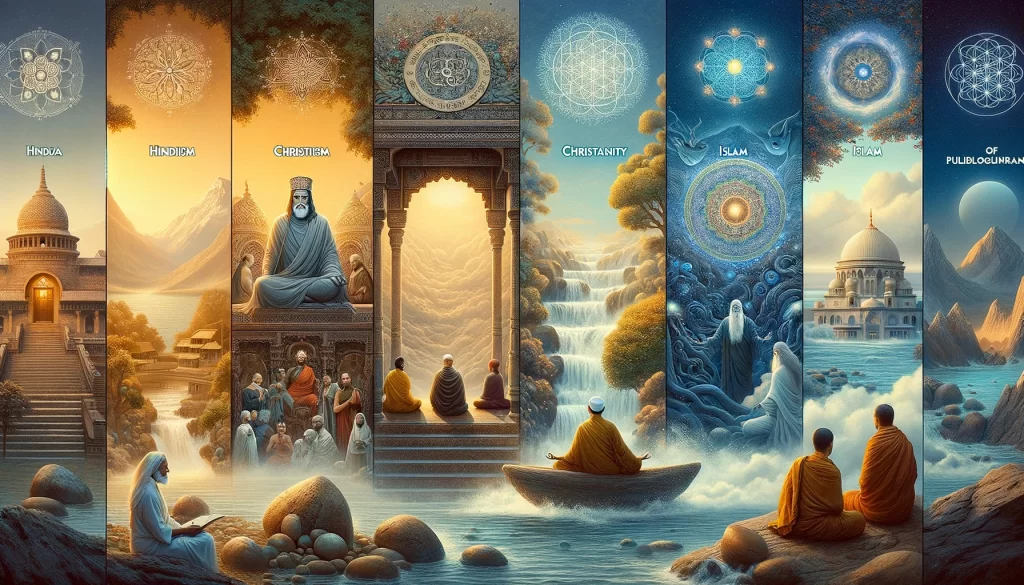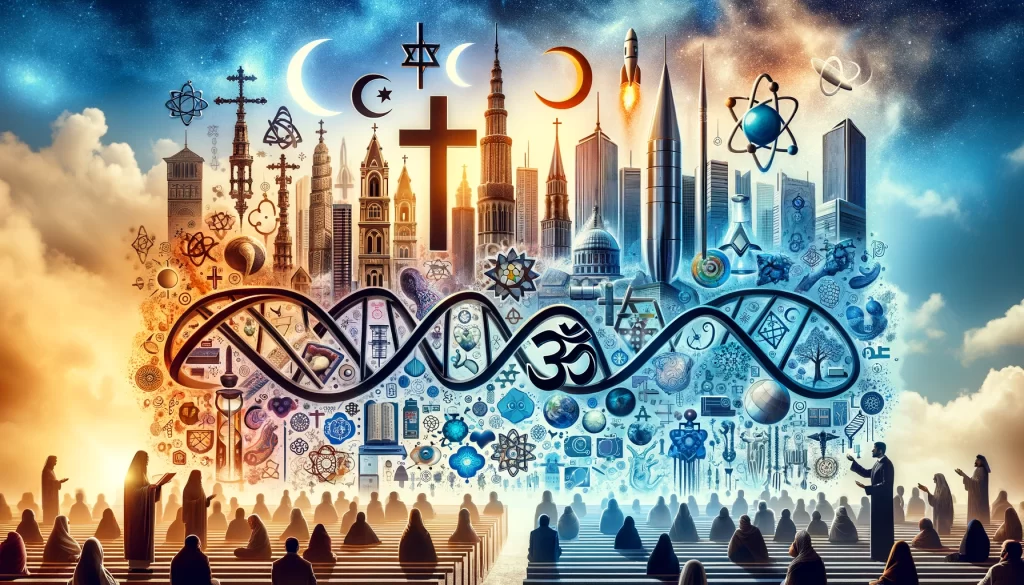Rethinking the Intersection of Religion and Science: Lessons from History and Beyond

This article is from my notes for a book I’m writing. With the recent opening of the Ram Mandir and Prime Minister Narendra Modi’s statement about the turning of the wheel of time, it’s the perfect time to talk about this topic. I want to explore whether religion is really like opium for people, as Karl Marx suggested, or if we’ve misunderstood what religion is all about.
The Western interpretation of religion, particularly following the views of Marx, Darwin, and Freud, has been misunderstood. When examining prominent atheists globally, it’s noticeable that most come from Western backgrounds. They often consider only theistic religions, based on the belief in a creator, as accurate representations of what religion is.
The idea that religion is the cause of violence on Earth doesn’t really make sense and isn’t backed by facts. Violence has been around way before religion ever came into the picture. Instead, it might be more useful to look into how religion has actually helped decrease violence and played a part in moving us from a wild, untamed society to a more civilized one.
Hegel once accurately stated, “What we may call the Greek way of looking at things has been the basis of all our thinking and doing.” Perhaps he was correct from his perspective then, as their understanding was mainly about Europe, which for them was the ‘world.’
When Thales, the first known Western philosopher, was born, the Buddha in India had already lived and shared his teachings, offering a modern philosophy that didn’t involve a creator deity. Buddhism considers the Buddha the tenth and final avatar in a series, with each avatar bringing different philosophical insights. Following the Buddha, the great philosopher Adi Shankaracharya presented an in-depth philosophy known as Advaita Vedanta, which does not rely on a creator to explain the truth.

In the West, thinkers like Marx and Darwin gained popularity mainly due to the misconceptions propagated by the Church and interpretations of the Bible. This trend among Western intellectuals, especially noticeable after the European Renaissance, was influenced by a growing need to challenge and reassess traditional religious and social beliefs. Newton’s contributions further advanced this shift in perspective during this period of intellectual reawakening.
The dominance of the Church in society led to conflicts when figures like Galileo, Darwin, and Newton proposed ideas suggesting that nature operates independently of a divine creator’s direct intervention. Their findings indicated that natural phenomena weren’t necessarily aligned with the descriptions found in the Bible. This led to a growing assumption in some circles that religion and science were fundamentally opposed and couldn’t be reconciled or discussed. This misconception fostered the belief that scientific inquiry and religious faith were mutually exclusive, contributing to a divide between science and religion.
There was a period in European history when many people believed that the world operated like a clock, with everything functioning precisely, mathematically explainable, similar to Newton’s laws. However, this view began to change with Einstein’s introduction of the General Theory of Relativity, which offered a new perspective on gravity. And now, quantum theories further challenge these ideas by suggesting that reality is not absolute but depends on the observer. Quantum science, while not directly equating the observer with thought, implies that observation influences outcomes. This concept resonates with Buddha’s teachings, emphasizing the power and significance of the mind and perception in shaping our understanding of reality.

Indeed, the philosophical landscape in India has been distinct from the beginning. Most of the six primary schools of Indian philosophy don’t focus on a god as a creator. Here’s a brief overview showing this:
- Nyaya: This school focuses on logic and epistemology, emphasizing methods of reasoning and the pursuit of knowledge. It doesn’t center around the concept of a creator god.
- Vaisheshika: Known for its atomistic and naturalistic approach, Vaisheshika discusses the physical universe’s makeup but doesn’t delve into the idea of a creator god.
- Samkhya: Samkhya is explicitly atheistic. It posits that reality consists of two eternal principles, Purusha (consciousness) and Prakriti (matter), without involving a creator deity.
- Yoga: While based on Samkhya, Yoga includes theistic elements, but its focus is more on mental discipline and spiritual practices for self-realization, not on a creator god.
- Mimamsa: Initially, Mimamsa was focused on interpreting Vedic texts and performing rituals without emphasizing a creator. However, later texts integrated more theistic views, often using anthropomorphism as a teaching tool.
- Vedanta: Though it discusses the ultimate reality of Brahman, Vedanta’s various sub-schools have different views on the nature of this reality, and not all see it as a creator god.
Anthropomorphism in these philosophies and later Puranas conveyed complex ideas in a relatable manner, similar to how formulas are used in science. Just as formulas in science are tools to understand and explain more profound concepts, not laws themselves, anthropomorphic representations in Indian philosophy and mythology serve as means to understand profound spiritual and philosophical concepts.
This knowledge wasn’t part of Western scientific understanding; if it was known, it needed proper credit. Western philosophy began in Ionia, which had strong trade and business ties with Asia. However, that’s a separate matter.
The West has often mistaken the Puranas for the entirety of Indian philosophy. With their limited understanding, figures like Müller and Macaulay added incorrect interpretations to this body of knowledge. They attempted to interpret centuries-old wisdom through the lens of their own few hundred years of cultural and historical context.
India has historically thrived and developed in harmony with its religious diversity. Even atheistic philosophies like Charvaka were an integral part of Indian culture and were widely accepted. This acceptance of atheism wasn’t seen as a conflict but as one of the many valid perspectives within the rich tapestry of Indian thought.
Scientific research and investigation have long been integral to the Indian way of thinking, often intertwined with the religious system. However, this connection with religion upholds the significance of India’s remarkable contributions in various fields, such as trigonometry, astronomy, and Ayurveda. These disciplines and their developments testify to India’s rich and diverse intellectual heritage.

Ancient India’s contributions to science and knowledge extend beyond trigonometry, astronomy, and Ayurveda. Here are some additional significant scientific achievements:
- Mathematics: Ancient Indian mathematicians made groundbreaking contributions, especially in algebra, geometry, and number theory. The concept of zero as a number, along with the decimal system, was developed in India. Mathematicians like Aryabhata, Brahmagupta, and Bhaskara II made significant contributions.
- Surgery and Medicine: Sushruta, often called the “Father of Surgery,” wrote the Sushruta Samhita, detailing various surgical procedures and medicinal practices. This work laid the foundation for surgery in the ancient world.
- Metallurgy: Ancient Indians were advanced in metallurgy. The Iron Pillar of Delhi, which shows minimal signs of rust despite being thousands of years old, is a testament to their skill in metalworking.
- Astronomy: Indian astronomers contributed significantly to understanding celestial bodies and their movements. Aryabhata’s work, for instance, accurately calculated the Earth’s rotation and orbit.
- Architecture and Engineering: The architectural marvels of ancient India, like the step wells and temples, and the urban planning of cities like Harappa and Mohenjo-Daro, demonstrate advanced engineering and architectural skills.
- Textiles: India was renowned for its textiles and dyeing techniques, and Indian cotton and silk were highly valued worldwide.
- Botany and Agriculture: Ancient Indians had extensive knowledge of plants and agriculture. Texts like the Vrikshayurveda are dedicated to botany and plant sciences.
In India, Jainism offers a unique philosophy known as Anekantavada, which boldly acknowledges and accepts different viewpoints, asserting that each can be correct from its perspective.Jainism offers a really interesting analogy to explain how our limited perspectives can lead to different viewpoints. It’s about an elephant and six blind people. Each person touches a different part of the elephant and ends up with their own idea of what the elephant is like, based on the part they felt. This story is used to show how our understanding is often limited by our senses and experiences.
The Rigveda, considered the world’s oldest book, also conveys a similar idea. It states, “Ekam sat vipra bahudha vadanti,” meaning that while truth is singular, wise people perceive and describe it in various ways, each through their interpretive lens.
Other parts of the world don’t have philosophical concepts as rich as these. When the world began recording theories and aimed to prevent disagreements and the abuse of power by the church, the whole idea of debates and peer reviews came into being, a practice initiated by Socrates.
Socrates, considered one of the wisest Western philosophers, introduced the dialectical method, which is ideal for uncovering material truths. However, it was a mistaken assumption to think this method could uncover all truths. This led to the belief that there’s only one way to know the truth, starting with Socrates. This perspective contrasted with India’s long-held belief in multiple viewpoints. India’s reluctance to adopt a single method and its rich cultural and philosophical diversity contributed to a divergence from this singular approach to truth.
In India, there has always been a focus on exploring the inner world and delving into the mind, whereas Western philosophy primarily sought understanding the laws of nature. Although Indian scholars like Kanada, Aryabhata, and others also explored natural laws, they aimed to connect these with the inner world, recognizing its complexity. Unlike the Western approach, which often relies on mathematical formulas, dialectical methods, or peer reviews, Indian philosophy embraces its unique epistemology and methodologies for knowledge acquisition. This distinct approach is thoroughly detailed in philosophical schools such as Nyaya and Vaisheshika.

Human history appears to cycle between external focus and internal exploration, which is possibly what Prime Minister Narendra Modi referred to when mentioning the changing “time wheel.” This oscillation suggests a gradual global shift towards acknowledging realms beyond our sensory experiences, clarifying the true essence of religion. Such a shift might lead to a broader acceptance of an inclusive, non-coercive religion, and supportive of both internal exploration and external prosperity. This evolution could see the world looking again towards Asia, especially India, for insights and leadership.
The idea that religion fundamentally conflicts with scientific inquiry or modernity must be clarified. The issue lies not in religion but in our narrow interpretation. To reconcile religion with contemporary life and science, we need to broaden our view of religion, recognizing it as a supportive and enriching aspect of our quest for knowledge and a modern lifestyle.

